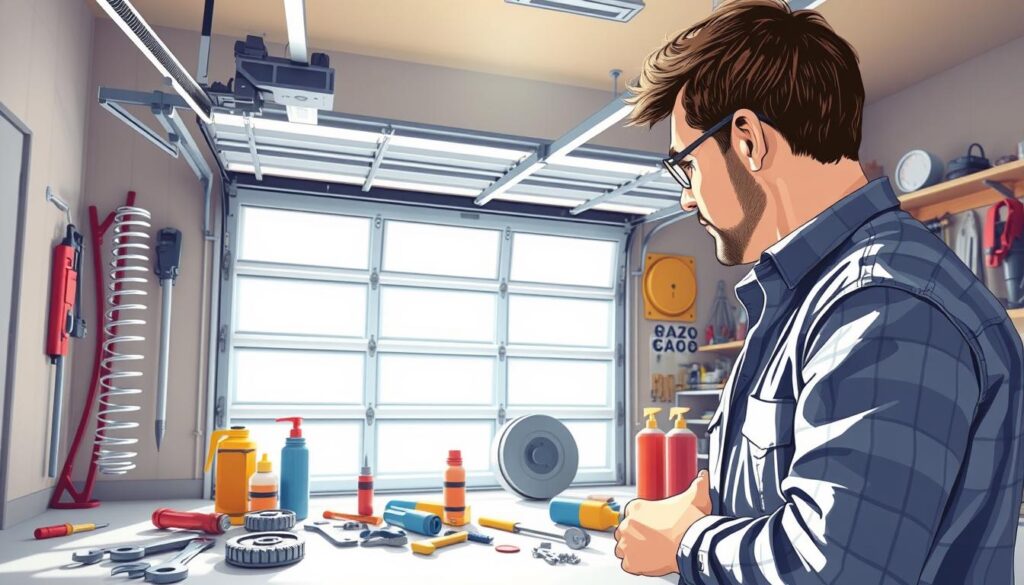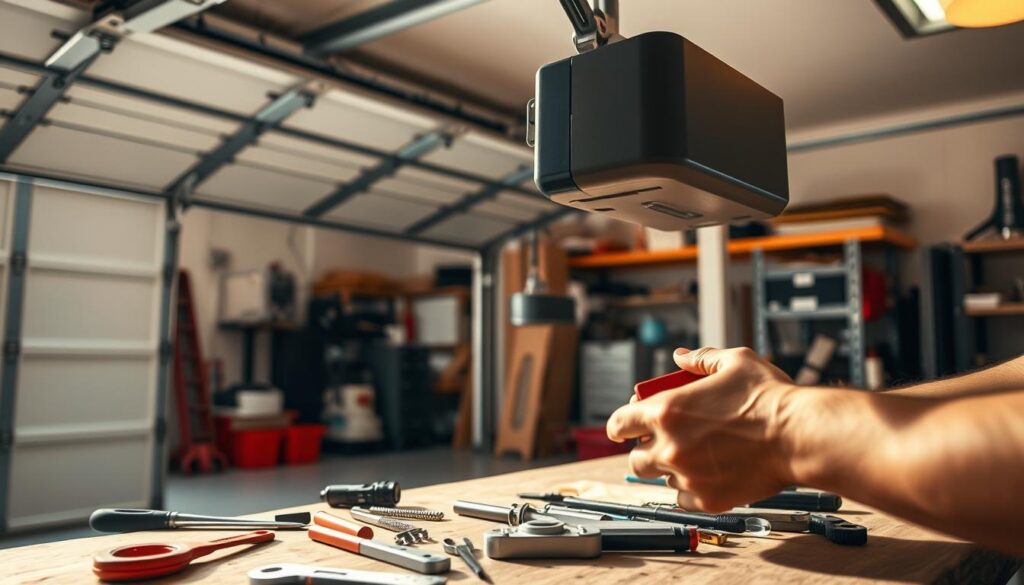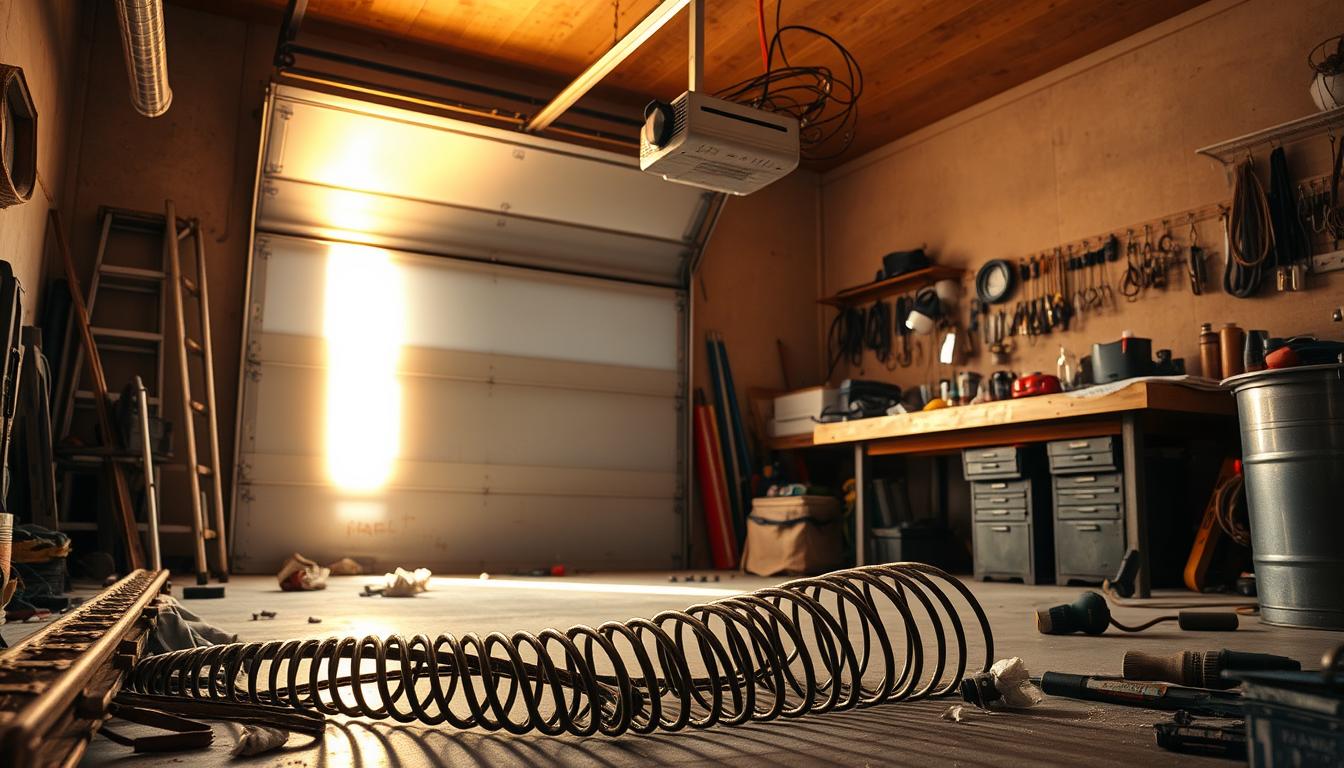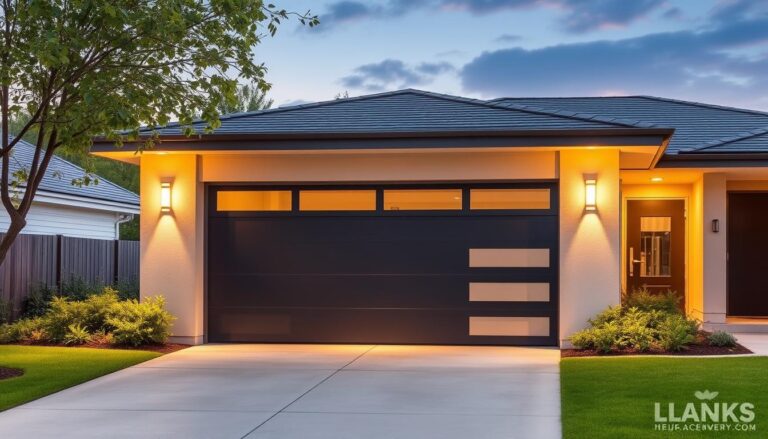Troubleshooting Common Garage Door Issues: From Noisy Tracks to Broken Springs
A garage door that doesn’t work right can really mess up your day. It’s important to know about common garage door issues. This helps keep your home safe and working well.
Issues like doors that don’t line up right, springs that break, and doors that make too much noise are common. Learning how to do DIY garage door maintenance can help you solve these problems.
Keeping your garage door in good shape is key to your home’s safety and security. We’ll look at the usual problems and share garage door repair tips. These tips will help you figure out and fix issues on your own.
Understanding Common Garage Door Problems
A broken garage door is not just a hassle; it’s a safety risk. Knowing about common garage door issues and how to fix them helps homeowners act fast. This keeps their garage doors working well.
Problems like misalignment, broken springs, and loud noises often point to bigger issues. These need to be fixed right away.
Signs Your Garage Door Needs Attention
Spotting when your garage door needs repair is key for preventative garage door care. Watch for odd sounds, uneven movement, or trouble opening and closing. If you see these signs, it’s time to check things out. This stops small problems from getting big.
Safety Precautions Before DIY Repairs
Before you start any DIY fixes, make sure to take safety precautions. You should know the basics of garage door mechanics. Always disconnect power and use safe lifting methods to avoid accidents.
Essential Garage Door Repair Tips for Homeowners
Dealing with a noisy garage door or a broken spring can be frustrating. Knowing how to fix these problems can save you money and time. It’s important for homeowners to know how to spot and fix common issues to avoid more damage and keep everyone safe.
Tools You’ll Need for Basic Repairs
To fix basic garage door problems, you’ll need some essential tools. You’ll need a socket wrench set, pliers, screwdrivers, and lubricants like silicone spray or garage door oil. Having these tools ready can help you fix small issues before they get bigger.
Quick Diagnostic Steps
Figuring out what’s wrong with your garage door is easy. First, check if the power source is working right and the door is connected. Then, look at the tracks and rollers for wear or damage. Lastly, test the door balance by opening it manually without the opener. If it’s hard to open, it might mean the springs need fixing.

When to Call a Professional vs. DIY
Some garage door problems can be fixed by yourself, but others need a pro. If you have broken springs or cable damage, it’s safer to call a professional. But, if your rollers are noisy or the tracks are off, you might be able to fix it yourself. Always think about how easy or hard the problem is before you decide what to do.
Fixing Noisy Garage Door Tracks and Rollers
Noisy garage doors are a common problem for many homeowners. Understanding the source of the noise is key to fixing it. By identifying and addressing the noise, you can make your garage door run smoothly and quietly.
Identifying the Source of Noise
To fix a noisy garage door, first find out where the noise is coming from. Common culprits include the tracks, rollers, hinges, and springs. Look for wear and misalignment to find the problem.
Lubrication Techniques for Smoother Operation
Lubricating moving parts can help quiet down your garage door. Use a silicone-based lubricant on hinges, rollers, and tracks. When you learn how to lubricate garage door hinges, remember to use it sparingly to avoid dirt buildup.
Tightening Loose Hardware
Loose hardware can also cause noise. Tighten any loose screws, bolts, or brackets to reduce vibrations and noise. Regular checks can stop hardware from coming loose.
Adjusting or Replacing Worn Rollers
Worn-out rollers are a big noise-maker. Check the rollers for wear and replace them if needed. This is a smart cost-effective garage door solution for a quieter door.
By following these steps, you can make your garage door quieter and more efficient. Regular maintenance, like lubrication and hardware checks, is essential for a quiet and functional garage door.
Troubleshooting Garage Door Opener Issues
Fixing your garage door opener can seem hard, but it’s often easy. Garage door openers have many parts, and problems can come from anywhere. Knowing how to find and fix these issues can save you time and money.
Remote Control and Keypad Problems
If your garage door opener won’t work with your remote or keypad, it might just need new batteries. Or, other devices might be causing interference. First, check the batteries. Then, make sure everything is paired right. If problems persist, try reprogramming or look for interference.
Motor and Chain Drive Malfunctions
The motor and chain are key parts of your opener. If the motor isn’t working, it might not have power or have a circuit board problem. For chain openers, look for wear or misalignment. Lubricating the chain can fix noise and operation issues.

Sensor Alignment and Safety Features
Modern openers have safety sensors to stop the door if something’s in the way. If these sensors are off, the door won’t work right. Make sure they’re aligned and clean. Adjusting them can fix the door not closing.
Power Issues and Circuit Breakers
Power problems can also cause issues. Check your circuit breaker to see if it’s tripped. If it is, reset it and try the opener again. If problems keep happening, it might be a bigger electrical issue that needs a pro.
By trying these steps, you can often fix garage door opener issues yourself. Regular DIY garage door maintenance can also stop many problems. This keeps your garage door working well and safely.
Dealing with Broken Springs and Cables
A broken spring or cable can stop your garage door from working. This is not just a problem; it’s also a safety risk. Knowing the signs and how to act is very important.
Recognizing Spring and Cable Failures
First, you need to know when springs and cables break. Look out for:
- A loud bang or snapping sound
- The garage door becoming uneven or hard to open
- Visible gaps or breaks in the springs or cables
Spotting these signs early can help you act fast.
Emergency Measures for Broken Springs
If you think your garage door spring or cable is broken, act quickly. First, avoid using the garage door until it’s fixed. Here’s what to do:
- Release any tension on the garage door by opening it manually, if you can.
- Use clamps or vice grips to keep the door from falling.
- Call a professional garage door repair service right away.
Professional Replacement Options
Replacing broken springs and cables needs special skills and tools. It’s best to get a professional to do it. They can fix the problem and check for other issues too, saving you money in the long run.
Cost Considerations for Spring Repairs
The cost to fix or replace garage door springs varies. It depends on the spring type and repair complexity. On average, it costs $100 to $300. Though it’s a big upfront cost, it’s vital for your door’s safety and function.
Knowing how to handle broken springs and cables keeps your garage door safe and useful. Regular checks and quick fixes help avoid other problems.
Preventative Maintenance to Avoid Future Issues
Keeping your garage door in good shape is essential. It ensures smooth operation and extends its life. By being proactive, you can dodge expensive repairs and keep your garage door in top condition.
Seasonal Maintenance Checklist
Following a seasonal maintenance checklist is a must. It includes tasks like lubricating parts, checking springs and cables, and testing the door’s balance. This way, you can spot problems early and avoid big issues, following the preventative garage door care approach.
Weather-Related Garage Door Problems
Weather can affect your garage door’s performance. Extreme temperatures can cause it to expand and contract, leading to misalignment or damage. To fight this, use weatherstripping to seal gaps and protect your door from the weather, a simple DIY garage door maintenance step.
Extending Your Garage Door’s Lifespan
Regular maintenance does more than just fix immediate problems. It also makes your garage door last longer. By using cost-effective garage door solutions like regular checks and quick repairs, you can make your garage door last for years, providing reliable service.
When to Invest in a New Garage Door System
Deciding when to get a new garage door system is a big choice for homeowners. The age of your door, how often it needs repairs, and its condition are key factors. These can tell you if it’s time for a new one.
If your garage door is old or breaks down a lot, getting a new one might be cheaper. A pro can check your door and suggest the best options for you.
Thinking about repair tips and your door’s state can help you decide. A new garage door can make your home safer, more energy-efficient, and look better.
Think about the long-term benefits and savings of a new garage door. It’s wise to talk to a pro to figure out what’s best for you.


